|
1.
CENTRAL/ WEST AFRICA
West Africa receives few inquiries ahead of summer holidays
There were no reports of further price changes for logs or
sawn lumber through to mid-June. Markets appear stable
at the present time, with Asian destinations continuing to
be the most reliable and steady buyers. There have been
some recent inquiries from European buyers asking for
sipo, iroko and azobe logs. This is unlikely to result in a
large volume business but could be an indication that
European de-stocking has now resulted in establishing a
basis for new purchases in select species. The same cannot
be said for sawn lumber, although there are some reports
that stocks of the prime, favorite timbers are becoming
less available generally and that gaps in stock are less able
to be filled by inter-merchant trading.
Some European traders now appear to be more optimistic
for their future prospects as we move into the third quarter
but it is unlikely the continental buyers will want to make
any large commitments ahead of the vacation period that
in mainland Europe begins at the end of June.
Unemployment levels are still rising in most countries,
especially in the UK and although house resale prices have
stabilized and stock markets have been rising, the
economic and financial crisis is far from over. In the UK,
the various government schemes for assisting with housing
finance and avoidance of repossessions has not yet trickled
down to implementation on the ground and thus the
housing sector is expected to remain very depressed for
some time. West African exporters believe China has
reversed the trend toward increasing sawn lumber imports
in place of logs as demand and inquiries for sawn lumber
have been low, while log buying has been maintained at a
moderate to stable level. Some West African producers are
considering even further reductions in output of sawn
lumber and downstream components, and even some
temporary mill closures.
As reported at end-May, the market still appears to be
finely balanced and stable, with most of the emphasis on
log business. Exporters consider there will be continued
market stability through to the end of the current quarter.
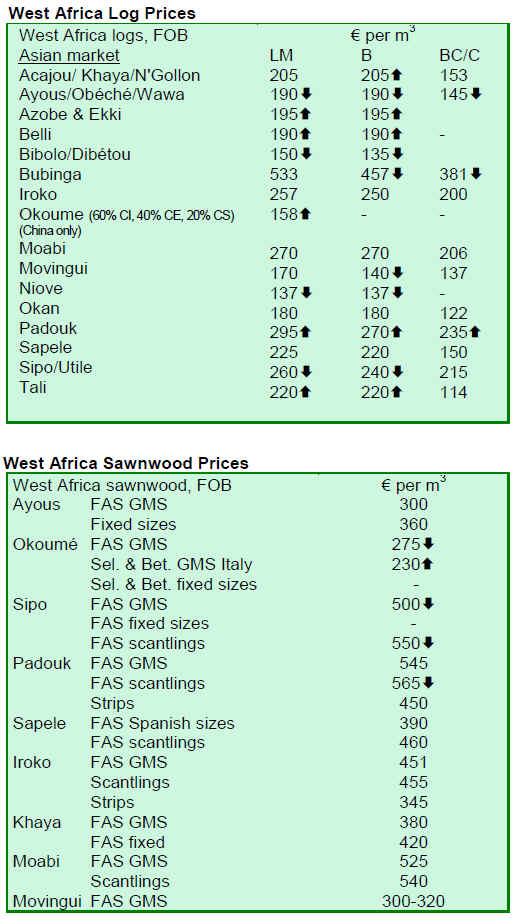
2. GHANA
Ghana*s Forestry Commission lauds modified forest
system
Mr. Michael Kofi Benni, Sunyani Area Manager of the
Forestry Commission, has lauded the modified &taungya*
system as a successful government intervention. The
system allows degraded forest reserves to be reforested
with selected tree species and inter-cropped with food
crops, and involves active farmer participation.
Speaking in an interview with the Ghana News Agency,
the Sunyani Area Manager said 10,000 hectares of
degraded forests nationwide had been replanted in spite of
the heavy forest destruction caused by wildfires in 1983.
About 1,558 farmers in 36 fringe communities in the
transition zone are benefiting from the taungya system
initiated in 2002, which offers 40% of proceeds from sales
on standing tree value to participating farmers.
Mr. Benni said more than 10,000 metric tons of food crops
were also produced to boost the region's food production.
However, he expressed regret that most farmers had failed
in their responsibility to tend forest reserves. Mr Benni
said illegal chain saw operations, persistent annual
wildfires and encroachments on land area have stifled
reforestation activities and appealed to farmers to remain
committed to tending forest reserves.
FC cautions timber producers and exporters
Timber producers and exporters in Ghana have been
advised by the Forestry Commission (FC) to support
initiatives designed to help the country meet the current
global requirements for legal sustainable timber. The
appeal was made by the Acting Executive Director of the
FC, Mr. Henry Coleman, during a workshop on the US
Lacey Act for timber millers, producers, exporters and
other stakeholders at Akyakrom, in Kumasi. He advised
that any suspicious unethical business practices may be
detrimental to Ghana*s commitment to ensuring legality in
the eyes of the international community and might
negatively affect the country*s efforts to increase earnings
from the sector.
Minister hears views of local timber firms
The Minister of Lands and Natural Resources, Alhaji
Collins Dauda, has visited a number of timber firms in
Kumasi to acquaint himself with the progress made by and
problems confronting the timber industry. Among the
firms visited were: the Bibiani Logging and Lumber
Company Limited (BLLC); Naja David Veneer and
Plywood; Modern Wood Technology and Company;
Maxwell Owusu Timbers Limited; and Logs & Lumber
Limited (LLL). At the BLLC, the Executive Director of
the company, Mrs. Comfort Wireko Brobby, complained
of the: lack of raw materials; difficulty in acquiring
concessions; illegal chainsaw operations; and
encroachment by farmers on allocated land.
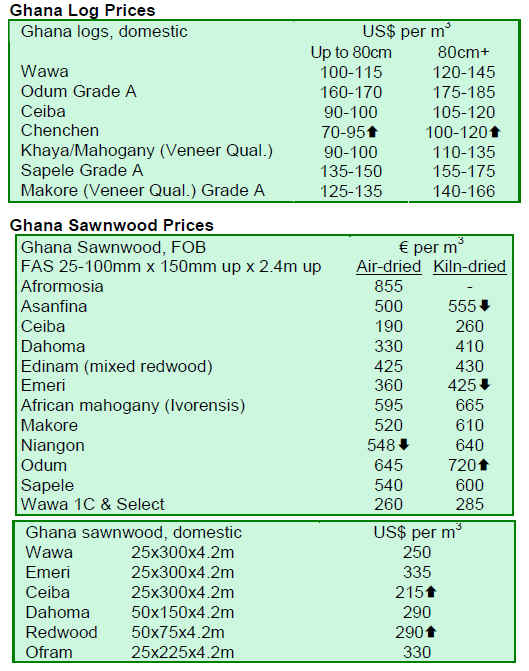
3.
MALAYSIA
Malaysian timber products prices remain weak
Marketwatch reported that prices of Malaysian timber
products remained weak as plywood mills reduced
production by 35% to 40%, while furniture manufacturers
and sawmills were cutting production by up to 50%. The
demand for Malaysian timber products is highly dependent
on housing starts of major importing countries such as
Japan and the US.
Housing starts in Japan fell for the sixth month in a row,
according to the Japanese Ministry of Land, Infrastructure,
Transport and Tourism. Housing starts declined 32.4% in
April 2009 compared to the same month a year ago,
registering an estimated 66,198 units. During the same
period, overall building starts in Japan fell 32.5% to 9,431
units. In addition, construction orders from Japan*s 50
leading domestic construction firms declined 25.9% to
JPY562.8 billion (approx. USD5.8 billion).
US housing starts declined 13% to an annual rate of
458,000 units in April 2009, reported Bloomberg. The
decline was led by units for multifamily starts, which
showed a drop of 46%. Total construction on multifamily
homes, such as townhouses and apartment buildings,
declined to 90,000 in April 2009, down from 167,000 in
March 2009.
Some timber trade manufacturers continue to be of the
opinion that it may take up to 3 to 4 years for the
Malaysian timber industry to recover to the level estimated
before global economic downturn.
Global Forestry Services to audit FMUs
An independent third-party company, Global Forestry
Services (GFS), will provide audits of long-term licenses
for Forest Management Units (FMU) under a 2-year
project in the state of Sabah, according to the state forestry
director, Mr. Sam Mannan.
The Daily Express reported that the scope of work will
include but not be limited to a legal audit of the licensees,
which include both an approved Forest Management Plan
(FMP) and approved Annual Work Plan (AWP). In
addition, the performance of licensees will be based on the
level of compliance against an agreed checklist.
The project, &The Sabah Forestry Department-European
Union-Malaysia Timber Council Independent Third Party
Auditing*, will cost about RM964,390.00. The Dutch
government and the German Agency for Technical Cooperation
will be contributing EUR193,673 (RM950,000)
for the first year activities.
Mr. Mannan added that this may help to address the
number of issues and challenges under the proposed EUMalaysia
Voluntary Partnership Agreement on Forest
Law, Governance and Trade. Furthermore, it will assist
licensees to be certified under a credible and
internationally recognized system, which will be made
compulsory by year 2014.
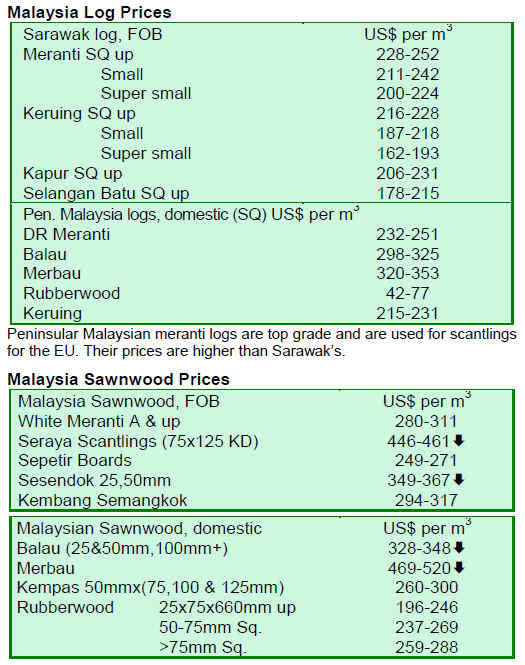
4.
INDONESIA
No upturn for Indonesian furniture exports
Exports of Indonesian furniture declined by 35% in the
first quarter of 2009 compared to the first quarter of 2008,
noted The Jakarta Post. According to the Association of
Indonesian Furniture and Handicraft Exporters (Asmindo),
the decline was expected grow larger during the first half
of 2009. Total exports for April 2009 stood at USD141.2
million, a decline of 14.9% against March 2009 exports.
A report released by the Central Statistics Agency (BPS)
and summarized in Antara News stated that exports of
furniture, bedding, cushions, and stuffed furnishing from
January 2009 to April 2009 stood at USD578.2 million, a
decline of 24% against the same period in 2008. In total,
Indonesia*s exports of furniture are expected to fall up to
30% in 2009 against 2008 exports of USD2.65 billion.
Italy*s trade with Indonesia continues strong
According to Antara News, Italian Trade Commission
Chairman Angelo Infresino commented that trade with
Indonesia has largely been unaffected by the global
economic downturn for the 2008-2009 period. From 2008
to May 2009, Indonesia*s exports to Italy stood at USD1.6
billion while its imports from Italy stood at USD1 billion,
reported The Jakarta Post. Italian Ambassador to
Indonesia Roberto Palmieri added that Italy is now the
third largest trading partner with Indonesia in the EU, after
Germany and the Netherlands.
Carbon trading could bring nearly USD15 billion to Indonesia
According to The Jakarta Post, Indonesia may earn up to
USD15 billion (Rp 150 trillion) a year on carbon-trading,
said Daniel Murdiyarso, a climate researcher from the
Center for International Forestry Research (CIFOR). He
added that if Indonesia could manage 20% of its forest
emissions, the country could gain up to USD3 billion per
year at the carbon price of USD5 per ton. The prevailing
traded price of carbon is between USD5 to USD10 per ton.
Nur Masripatin, Secretary for the Indonesian forestry
research and development agency said the impact of
deforestation in Indonesia could be reduced substantially if
the international community could provide a grant of
USD4 billion until 2012 to finance livelihoods of local
people and to stop forest conversions. Of course, this is
contingent upon a combination of decisions to be taken on
forestry-related voluntary REDD mechanisms at the
climate change talks in Copenhagen 2009 and the further
development of carbon markets.
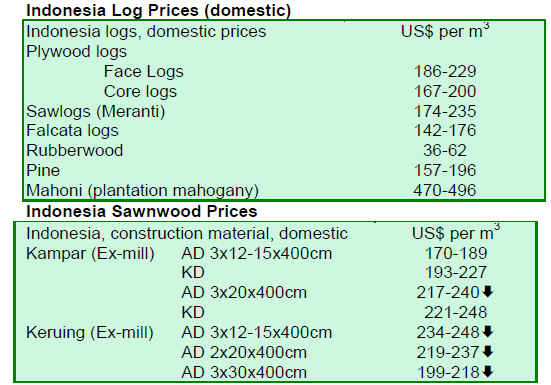
5.
MYANMAR
World Environment Day held in Myanmar
The Prime Minister of Myanmar, General Thein Sein,
recently opened World Environment Day 2009 in
Myanmar on 6 June 2009. During the event covered by the
New Light of Myanmar, the Prime Minister noted the state
of Myanmar*s forest protection measures, indicating a
&Dry Zone Greening Department* was formed in 1997 and
the Department has been carrying out reforestation
activities in 13 districts since that time. As part of the
activities, plantations have been established in dry areas to
prevent further deforestation from occurring in the
country.
Thirty-four nature conservation areas have been
established in Myanmar, covering 10,275 square miles.
Myanmar continues to apply the practice of sustainable
forest management and has been growing about 70,000
acres of plantation species such as teak, pyinkadoe and
padauk. The Prime Minister reported that the country also
expects to establish plantations on 55,200 acres of land by
the end of 2009.

6. BRAZIL
Illegal timber trade in Mato Grosso worth BRL600 million
According to O Liberal, Par芍 state is one area in the
Brazilian Amazon where a large amount of natural forest
logging takes place. Out of the total timber production of
Par芍, at least 30% is estimated to have come from illegal
sources, according to the State Secretary of the
Environment (SEMA). Such a proportion corresponds to 2
million m³ of timber per year, which is illegally traded
within and outside the state. This is equivalent to BRL600
million (roughly around USD300 million). Given the
massive volume and value of illegally traded timber,
measures to stop the illegal trade are often beyond the
control of state government.
These numbers reflect the reality of increasingly growing
conflict among the timber-related segment and the State.
In the clash between loggers and SEMA, the Secretary
started to control the situation with the support of the
Federal Police and the Public Prosecutor*s Office. The
inspectors have already identified two types of fraud. One
type of fraud is increasing the authorized timber stock for
logging. This fraud would have helped nearly 50,000 m³
worth about BRL15 million enter the timber trade.
The second type of fraud is more complex. It refers to the
issuance of interstate timber credits, which are issued
though fraudulent documents such as a Document of
Forest Origin (DOF) arriving from other states, duly
authorized by IBAMA, and corresponds to timber credits
allowed in other states. In the case of Par芍, a large volume
comes from the states of Mato Grosso, Amazonas and
Maranhão. The fraud happens when there is an approved
forest management project but the credits have not been
completely used for the approved project and the credits
are used to cover up illegal timber operations. The large
geographic size of the state has made timber control
measures very difficult.
Mega operation started to combat illegal logging
Gazeta do Povo reported that a mega operation to combat
environmental crime is being carried out in over 145 areas
of the Southern region of Paran芍 state. The operation,
&Angustifolia*, named after the Paran芍 pines (Araucaria
angustifolia) in the region, focuses on 14 towns and
involves 223 Federal Police inspectors from six Brazilian
states, the Brazilian Institute for Environment and
Renewable Natural Resources (IBAMA), the Paran芍
Environmental Institute (IAP) and the Military Police*s
Green Task Force.
The main purpose of the operation is to verify operations
causing deforestation and other environmental crimes. The
operation started in the last week of May and many illegal
activities have been detected in half of the 18 sites visited
on the first day. The operation is expected to expand to
other cities in the region and may last at least two weeks.
Timber exports drop in Alta Floresta
Timber exports from Alta Floresta, a major timber cluster
in the Brazilian Amazon, dropped significantly in the first
quarter of 2009 compared to the same period in 2008.
Non-coniferous timber exports fell 24% and sawnwood
cut into sheets (with a thickness greater than six
millimeters) slid over 83%, according to the Ministry of
Development, Industry and Foreign Trade. The main
reason for the export fall, noted S車 Not赤cias, was due to
the slowdown in purchases by the US after the economic
crisis that struck the country, which is still the main timber
buyer from Alta Floresta.
The data provided by the municipality was confirmed by
the federal government. Between January and April 2009,
the municipality exported USD1.9 million to the US. This
was 23.8% lower compared to the same quarter in 2008.
Timber companies in Alta Floresta have also moved their
production lines to Canada, Spain, France, Israel, among
other countries. Overall sales from January to April
declined 31% and exports reached USD3.8 million, down
from over USD5.5 million in the same period of 2008.
São Paulo to export rubberwood furniture
Brazil will start exporting rubberwood furniture, reported
Di芍rio Net. Currently, studies on the use of rubberwood
raw material for furniture and an inventory of rubber tree
plantations are being undertaken in the state of São Paulo.
The studies are being conducted by the Forest Institute
(IF), an agency linked to SEMA, and are expected to be
completed in October 2009.
Rubberwood is an appropriate material for furniture and is
also cost-effective. The furniture sector has expressed its
interest in manufacturing furniture from rubberwood and
the IF will assess the capacity needed to supply the raw
material for this market.
Rubberwood trees start producing latex from the 5th to 6th
year and remain productive for over 20 years. After this
period, their productivity declines and the trees are cut for
replanting. It is estimated that there are at least 350,000
rubberwood trees in Brazil ready to be logged.
Recently, the furniture sector participated in a technical
mission to latex-producing countries that showed how
countries are building capacity to produce rubberwood
furniture. Vietnam, for instance, has a project for the next
five years to export USD4 billion per year in rubberwood
furniture. Brazil currently exports USD1 billion in
furniture made primarily of pine and eucalyptus.
Rubberwood is expected to add value to the furniture
sector.

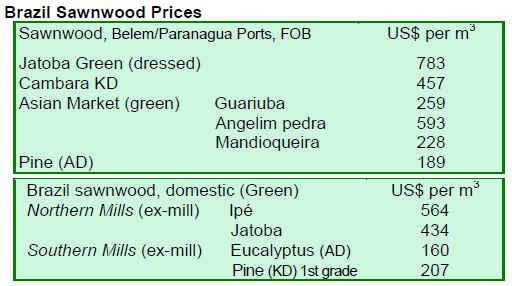
7.
PERU
Peru*s indigenous population continues battle for land
rights
Various news sources reported on the upswing in violence
over community lands in the Amazon, stemming from a
conflict over laws that threaten community rights. Civil
society organizations in Peru have signed a petition
addressed to the Government of Peru and the Interethnic
Association for the Development of the Peruvian Amazon
(AIDESEP), which rejects the current military repression
as a means to end conflict over land rights.
On 5 June, violence ensued during clashes between
indigenous people and the military. The BBC reported that
54 people were killed and over 100 indigenous protesters
were unaccounted for. Indigenous people had killed 14
police officers, which some news reports speculated to be
in retaliation for the violence against the indigenous
community. News sources also say the recent clashes are
expected to further polarize the country on this issue.
Peru*s wood exports drop nearly 46%
According to the Export Association of Peru (ADEX),
Peru*s wood exports from January 每 March 2009 were
USD31.7 million, a drop of nearly 46% from the same
period in 2008. In the January 每 March 2009 period, the
three main wood export destination markets were China,
Mexico and the US, which collectively received 78.5% of
wood sector exports.

From January 每 March 2009, the New Zealand market
showed an enormous boost of its wood imports from Peru,
with imports jumping nearly 192% against the same
quarter in 2008. The imported product responsible for the
steep increase was railway ties and similar products.
Similarly, Panam芍 increased its imports of Peru*s wood
products by 174%, with the bulk of the imports having the
commercial description &other sawn wood or wood
modified lengthwise, cut or unrolled*.
On the other hand, the Italian market decreased its imports
by 65.8% and stopped importing coniferous splints and
unassembled parquet flooring. It may be observed that
China*s imports continued to grow nearly 24%, while
Mexico and the US curbed their imports in March 2009
against the same month in 2008.
Semi-manufactured products represented nearly 45% of
wood products exported during the January 每 March 2009
period. Semi-manufactured exports in January 每 March
2009 were worth USD14.3, down over USD1.5 million
from the previous year. The main destination for these
products was the Chinese market, which received about
78% of the products from this category.
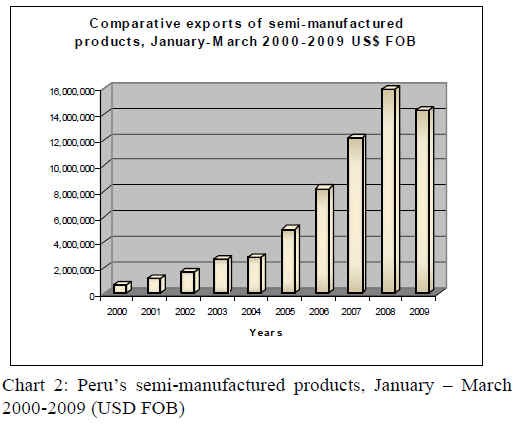
During the same period, sawnwood was the second largest
wood product by value to be exported from Peru. Exports
of sawnwood during January 每 March 2009 were USD10.6
million by value, while during the same quarter of 2008
sawnwood exports were USD28.6 million, a fall of 63%.
The destination for products from this sub-sector was
Mexico, which received 33.5% of total exports of this
type.
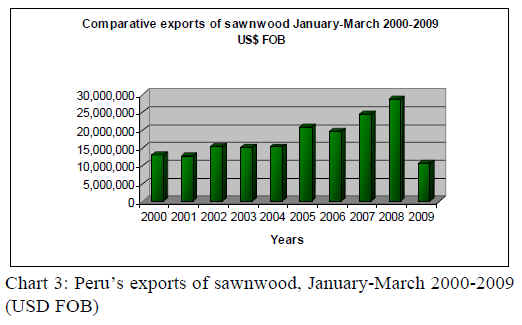
Exports of veneer and plywood during the three-month
period of January 每 March 2009 were USD3 million by
value, about a 61% drop from the previous year. The main
destination market for exports in this category was
Mexico, which received 71% of exports. Peru*s exports
for these products have been growing since 2003 until
2008, up until the US economic downturn began.
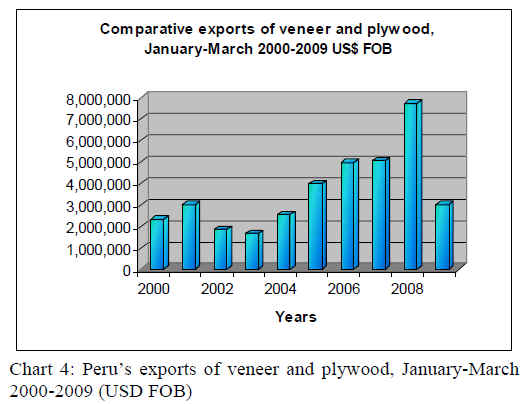
Exports of furniture and its parts were valued at USD1.7
million during the January 每 March 2009 period, while
exports for the same quarter in 2008 were about USD3.8
million, a year-on-year slide of 55%. Over the period, the
US decreased its imports 55%, mostly due to the effects of
the financial crisis.
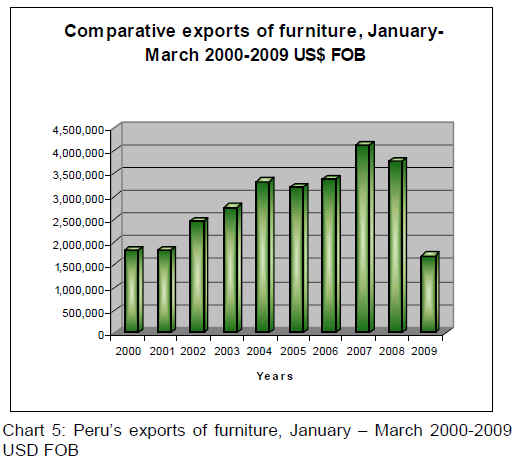
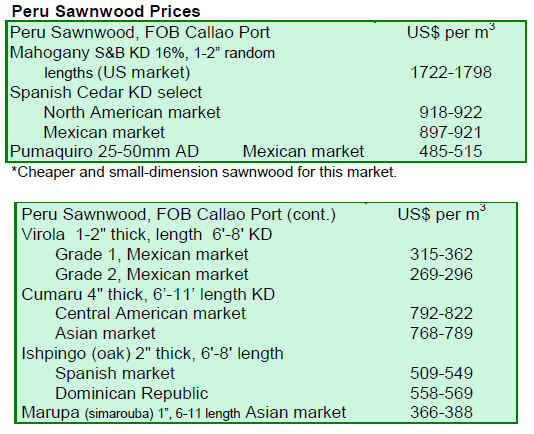

8. BOLIVIA

9.
Guyana
Market trends in Guyana hold steady during fortnight
Log prices for greenheart have remained stable, while
prices for purpleheart have been positive for the period 16
每 31 May 2009 compared to 1-15 May 2009. Prices for
undressed sawnwood have been encouraging, while prices
for dressed sawnwood have remained fairly stable when
compared to the period 16-31 May 2009. Splitwood prices
showed the greatest increase of all products for the 16-31
May 2009 compared to the same period in the previous
year.
Value-added products such as doors were a major
contributor to export value earnings for the 16-31 May
period compared to the same period in 2008. The
Caribbean market remains the leading destinations for
these value- added products.
Guyana addresses sustainable chainsaw milling
Guyana has established a multi-stakeholder dialogue
aimed to address the impacts of chainsaw milling and
align the chainsaw milling practices with other initiatives
on sustainable forest management (SFM). The dialogue
will support SFM while maintaining and/or enhancing
livelihoods for poor forest communities.
The multi-stakeholder dialogue is being established within
the framework of an EU-financed chainsaw milling
project. The project focuses on the broad theme of forest
governance in Ghana and Guyana, where there is a
prevalence of chainsaw lumbering and different
approaches are used to regulate these activities. Since
early 2008, the project has been reviewing chainsaw
lumbering practices in both Ghana and Guyana and has
created an inventory of key stakeholders* views on the
critical issues.
In both countries, there is the need for an appropriate
dialogue between principal stakeholders of chainsaw
lumbering to support rural livelihoods and ensure the
sector responds positively to national objectives for SFM.
The establishment of effective and meaningful
mechanisms for dialogue between the principal
stakeholders is expected to lead to a shared understanding
of chainsaw lumbering practices and associated socioeconomic
issues.
In the coming months, the multi-stakeholder dialogue will
be launched in Guyana and guided by stakeholders who
are represented on a task force (planning committee), with
the hope that they will take on a participatory approach to
forest governance and shape policies for SFM. It is
expected that the multi-stakeholder dialogue will run for a
period of one year.
Guyana steps up action on climate change
The Government of Guyana has recently stepped up its
action to address climate change. The Government
recently launched the Low Carbon Development Strategy
on June 8, 2009. As outlined in the press release, the
crucial components of this strategy will be the creation of
low-carbon employment and investment opportunities in
Guyana, sustained efforts to avoid deforestation and forest
degradation, strengthening open, transparent forest
governance, and establishing an international monitoring,
reporting and verification system for Guyana's forests.
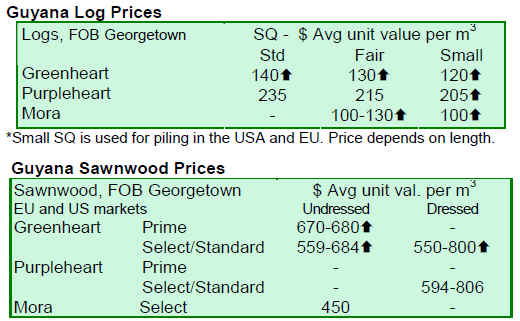
|